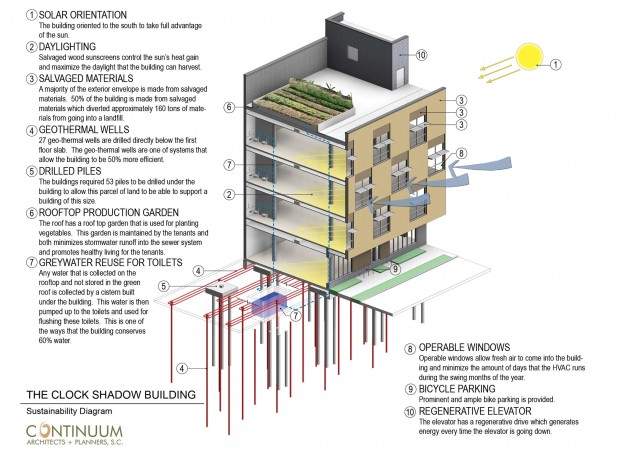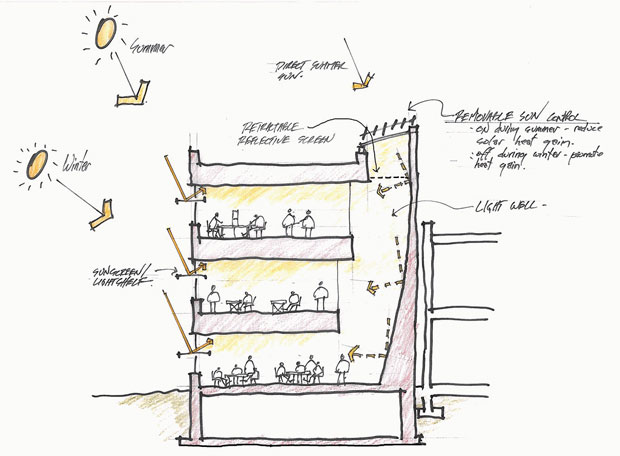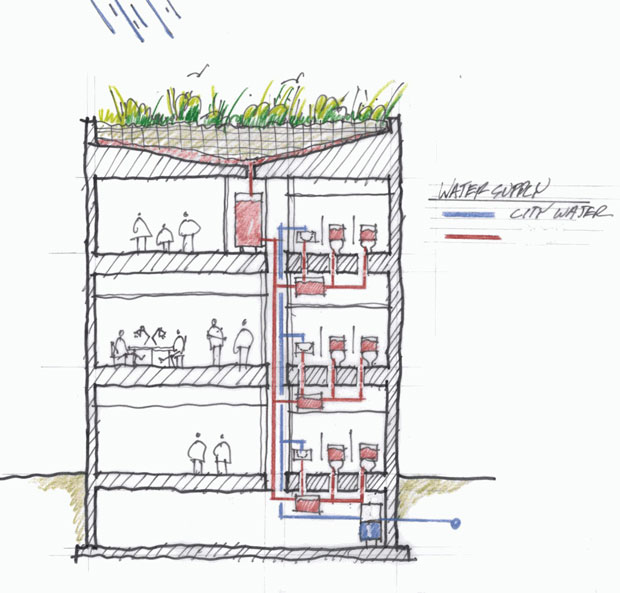An ambitious challenge.
Launched in 2006, the Living Building Challenge is a call to action for design professionals, contractors, and building owners to “create the foundation for a sustainable future in the fabric of our communities.” By evaluating a project in seven areas — site, water, energy, health, materials, equity, and beauty — the Living Building Challenge raises the bar on what it means for a building to be considered sustainable.
Fix Development strongly believes in the Living Building framework that models the built environment on patterns found in nature. From the start, our goal was official certification for the Clock Shadow Building, and although we fell short in a couple areas, we did meet much of the Challenge criteria and the building easily meets standards for LEED certification.
Site: Restoring a Healthy Coexistence with Our Surroundings
The building replaces an abandoned, contaminated lot, creating a new and living part of the community by cleaning a brownfield site; creating a compact, connected, pedestrian-scale infill development; orienting the building to take maximum advantage of the sun; providing a rooftop oasis for human activity and food production; and educating, entertaining and serving our community through a physical structure.
Materials: Using Products and Processes That are Safe and Healthy
Throughout the building you will see evidence of the careful selection of materials from efforts including excluding as many products as possible that have toxic ingredients or that rely on toxic procedures in their creation; choosing materials sourced as close to the building location as possible, to reduce the carbon footprint required for construction and to support the local economy; encouraging conservation by salvaging reusable materials like cream city brick and pickle barrel wood on the building exterior and local urban ash wood stair treads, recycled doors, sinks and hardware in the building interior; and incorporating local materials and showcasing local artisans.
Energy: Relying on Renewable Resources
The building design first aims to reduce demand for energy, then draws energy where needed from renewable sources by maximizing window orientations to capture natural light and solar energy; including operable windows to allow for natural air flow; providing elements like accessible, beautiful stairs to encourage walking over mechanical elevator use; reducing demand on energy further by using state-of-art energy efficient lighting and innovative regenerative elevator technology; and capturing the efficient energy of the earth’s thermal mass through geothermal heating and cooling.
Water: Striving for Minimal Impacts
The building recognizes fresh water as a critical and precious resource by; harvesting all storm water on site for use to irrigate rooftop food production; capturing excess rainwater and building grey water discharge into a cistern that re-circulates to feed the internal water demand for toilet flushing; and encouraging water conservation practices by building occupants.
Health: Maximizing Physical and Psychological Health and Well-being
Recognizing that people spend a great deal of time indoors, the indoor building environment aims to be healthy by creating a civilized environment with operable windows for light and healthy air; reducing toxins, preventing smoking, and providing good ventilation; providing an artistic environment connected to nature that inspires and motivates; and renting space to tenants committed to holistic health and well being for all.
Equity: Supporting a Just Equitable World
The building incorporates concepts of social and financial justice, through its creation and operation by acknowledging that we all have rights to and should have equal access to nature, health, and justice; creating a place that is built to the human scale and celebrates human places; involving local stakeholders in the design, construction, and operation through an inclusive process; and establishing financing and renting approaches that strive for economic prosperity for all.
Beauty: Celebrating Design that Creates Transformative Change
This building is designed to be a beautiful beacon that inspires our positive future by elevating spirits, enriching lives, creating inspiration, providing education, offering human delight, and inviting celebration of culture.
Learn more about the Challenge by reviewing the Living Building Challenge 2.0 overview PDF from the International Living Building Institute.



